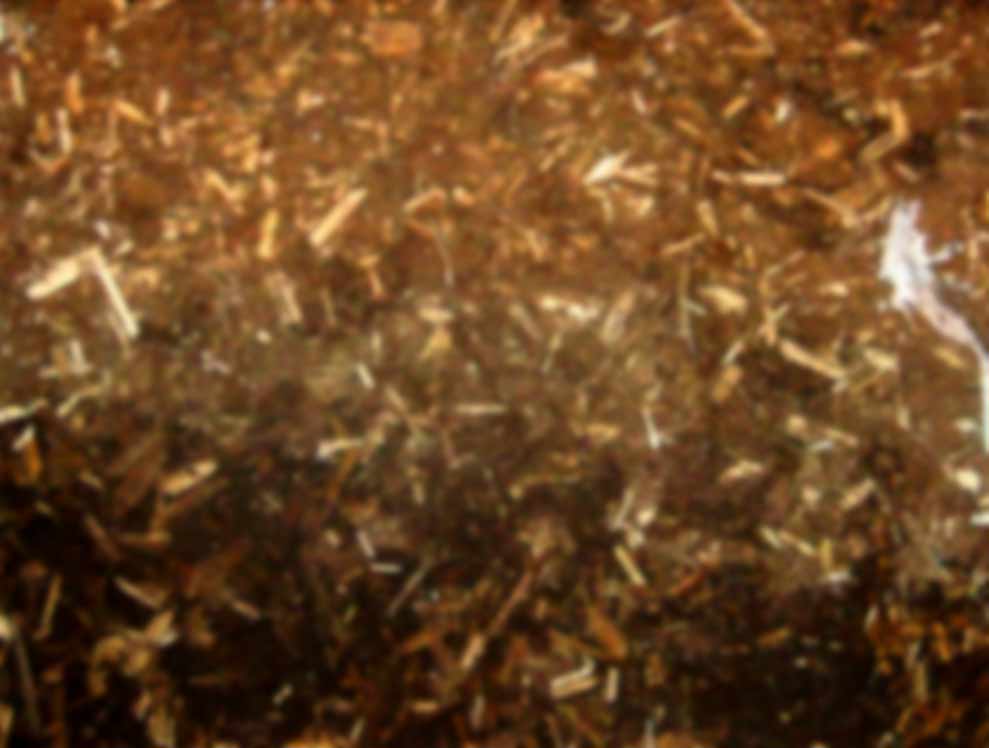In The Beginning:
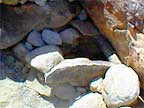 When we arrived at my land November 20, 2001 after a 30+ year absence, we pitched a green tarp tent but lived primarily out of our minivan. One of our most immediate concerns was, of course, how to relieve ourselves in relative privacy. We re-commissioned the method that I had used back in the '70s, a board between rocks straddling a naturally sloping trench that disappeared beneath a large boulder. A rock wall extended from one side of this to provide privacy. Back then it was adorned with a toilet ring in a plywood box that had come with the old trailer that also served to hide that spot from the road, but that box & ring had long since fallen apart, as had the trailer. We managed to make this work for about 5 weeks, along with frequent trips to the various toilets around the town 3 miles away.
When we arrived at my land November 20, 2001 after a 30+ year absence, we pitched a green tarp tent but lived primarily out of our minivan. One of our most immediate concerns was, of course, how to relieve ourselves in relative privacy. We re-commissioned the method that I had used back in the '70s, a board between rocks straddling a naturally sloping trench that disappeared beneath a large boulder. A rock wall extended from one side of this to provide privacy. Back then it was adorned with a toilet ring in a plywood box that had come with the old trailer that also served to hide that spot from the road, but that box & ring had long since fallen apart, as had the trailer. We managed to make this work for about 5 weeks, along with frequent trips to the various toilets around the town 3 miles away.
A Chemical Toilet:
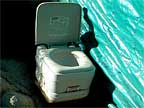
On December 29 we purchased a Coleman chemical toilet at Kmart. This sturdy plastic box proved to serve us well for the next 7 years of winter-long visits. The statement "to serve us well" is a relative phrase; it did have to be emptied every few days. Regardless of how often we were able to drive quickly into town, it did tend to fill up with liquid. Though I had no problem making use of the rock privy as needed, my wife preferred the more elegant convenience.
In May of 2002 the trailer became operational and the chemical toilet moved right in with us.
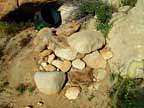
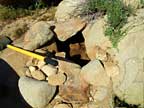 An inconspicuous hole was dug away from our abode, surrounded and covered with a pyramid of rocks. Into this went the contents of the tank, as needed. This often meant an emergency run to the hole with the detachable toilet tank and a bucket of grey water, regardless of time of night or weather, to dump it, rinse it, and dump that. After a thorough wiping of the exterior with a paper towel, 4 ounces of a biodegradable chemical deodorant were poured into the tank. Then back inside to its position on the Rubbermaid box for use by whichever person happened to be waiting in desperation at the time.
An inconspicuous hole was dug away from our abode, surrounded and covered with a pyramid of rocks. Into this went the contents of the tank, as needed. This often meant an emergency run to the hole with the detachable toilet tank and a bucket of grey water, regardless of time of night or weather, to dump it, rinse it, and dump that. After a thorough wiping of the exterior with a paper towel, 4 ounces of a biodegradable chemical deodorant were poured into the tank. Then back inside to its position on the Rubbermaid box for use by whichever person happened to be waiting in desperation at the time.
The 7" high Rubbermaid box not only served to raise the toilet to a more convenient height, but also its recessed lid was good for catching those inevitable minor spills of grey water used to pre-fill the toilet bowl about half way before use. The toilet does have an additional tank for storing flush water, but this proved to be fairly useless early on - it was easier and quicker to just keep a bucket of water handy. Eventually the bellows-like hand pump cracked at the seams anyhow, even though it was almost never used.
Given a month or two to compost, the dried contents of the hole could be easily removed with a shovel and buried elsewhere. By then it was just a fairly unrecognizable dry brown cake. My wife usually returns east about two months before I do. During this time I generally have no problem making it to Home Depot or Wal-Mart to do my thing. That gives the contents of the hole time to dry out in the desert air before I have to remove it.
Keep in mind that if you are thinking about getting a chemical toilet, you will need at least one person who is capable of handling all this, especially regarding the following matter:
To flush the toilet, a handle on the front must be pulled outward, allowing the contents of the bowl to drop into the tank. Ideally, everybody that uses the toilet will also look into that tank to ascertain that it is not yet full. Since not everybody will do that every time, they often end up with a bowl full of stuff that will not flush. That is when the one that can or must deal with it gets called into action.
It is indeed possible to flush that final bowl. With the handle out, so that the flush hole is open, one must slowly lift the toilet, and very slowly set it down, lift it again, and set it down, and lift it again, perhaps tilting it a bit now and then. One may notice bubbles rising to the top as hidden cavities within the toilet fill and the water level in the bowl lowers a bit more with each lift. The weight of the full tank causes it to bulge at the bottom when lifted, thereby creating more space within the tank for the bowl to empty into. Setting it down will raise the level again, but not as much because it is also forcing liquid into the empty interior spaces around the bowl. One hand must be holding the handle during this procedure so that when the water level drops below the hole while holding the toilet up in the air, the hole can be gently closed. This usually gets it all, but there will be times when one must carry it carefully out to the dump hole with something still in the bowl. Usually this is just liquid since the heavier stuff tends to fall through the hole displacing the liquid.
If this is all done in slow motion, one will rarely have deal with the unexpected bubble bursting up into ones face.
There is a rubber gasket around the aforementioned hole. This gasket should be sprayed with WD-40 periodically which is then rubbed in with a folded paper towel to keep the rubber pliable. Otherwise the rubber will dry up and deteriorate. Rubbing it in vigorously will help clean out the accumulated e-coli that is trapped within the gasket as the plastic flap slides in and out over time. Likewise the rubber ring inside the screw cap that keeps the liquid from leaking out when somebody sits on the toilet, compressing the tank in the process.
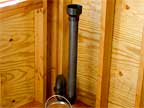
The nice thing is that the biodegradable deodorant does work; the smell is not all that bad.
A work shed was added in 2006 which included a dormer and a urinal. It became a utility house in 2008 with the addition of solar equipment and a computer desk. We were coming up in the world.
A Compost Toilet:
 On January 10, 2010, we received our Sun-Mar Compost Toilet purchased on Amazon.com from In The Swim Pool Supplies because they had the best price at the time, including shipping. This changed the game entirely. Suddenly there was no longer a need to run into town for that purpose, and there was nothing that had to be emptied out and cleaned every few days. Instead of flushing with water, we drop in a scoop of compost mix and occasionally a little microbe mix. The savings in gas and water probably more than pay for the mixes. We love this toilet; it has become a member of the family. According to my wife, we can now refer to our home as a cottage, rather than a camp.
On January 10, 2010, we received our Sun-Mar Compost Toilet purchased on Amazon.com from In The Swim Pool Supplies because they had the best price at the time, including shipping. This changed the game entirely. Suddenly there was no longer a need to run into town for that purpose, and there was nothing that had to be emptied out and cleaned every few days. Instead of flushing with water, we drop in a scoop of compost mix and occasionally a little microbe mix. The savings in gas and water probably more than pay for the mixes. We love this toilet; it has become a member of the family. According to my wife, we can now refer to our home as a cottage, rather than a camp.
This COMPACT version is Sun-Mar's smallest and least expensive toilet, suitable for one or two people. We had space considerations and this one fit perfectly; a half inch more and I would have had to move a wall. However, I would recommend the next one up, the EXCEL, only $70 more, for three to four people, since you never know who might drop by and stay awhile. By the way, concerning adjacent walls, make room for your knuckles. You have to rotate a handle on the front, and it goes the full width of the toilet.
From its first use on February 1 to my departure on May 6 it was put to full use and never had to be emptied. There was no stink (fan required), no mess, no trouble and it was comfortable to use, just like a real toilet. Every few days, I spin the handle to rotate the internal drum a few turns. This mixes everything together and hides the accumulating toilet paper so all you usually see in the hole is a dark brown mulch. When we return in the Fall, it will probably be time to spin the drum in the opposite direction which will dump some of its contents into a drawer which can then be carried out and dumped around the new tree I just planted.
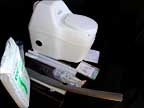
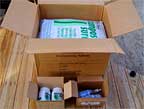 The original package included a large bag of Compost mix, a tiny packet of Microbe Mix, an 8 oz bottle of Compost Quick, a compost rake, and the parts needed to assemble the vent. That bag lasted into May, but since 1/3 was used to prime the system, subsequent bags should last about a third of that time longer. On February 24 an additional order of five 8 gallon bags of Compost mix, two 16 oz jars of Microbe Mix, and two 16 oz bottles of Compost Quick arrived from Sears.com. That should last a few years.
The original package included a large bag of Compost mix, a tiny packet of Microbe Mix, an 8 oz bottle of Compost Quick, a compost rake, and the parts needed to assemble the vent. That bag lasted into May, but since 1/3 was used to prime the system, subsequent bags should last about a third of that time longer. On February 24 an additional order of five 8 gallon bags of Compost mix, two 16 oz jars of Microbe Mix, and two 16 oz bottles of Compost Quick arrived from Sears.com. That should last a few years.
The Sun-Mar Compost mix, aka: Compost Sure, looks like any mulch but it contains various other components selected for their synergistic composting ability. Apparently regular mulch, peat moss and wood chips would not do the job as well. $12+ for one bag is not too bad. The granular Microbe Mix encourages the composting process. It also contains citronella which the flies (and I) find rather unpleasant. Fortunately the fan removes the scent and the flies that want out, if any. The Compost Quick pump spray also enhances the process and it works well at washing away the splatter left behind by male urination.
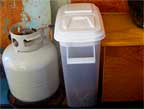 The Compost mix comes slightly moist so it should be stored where it can get plenty of ventilation. Otherwise it could get moldy. The bag is perforated. Hopefully bugs won't find those holes interesting. However, when the bag is opened, it should definitely go straight into an air-tight container.
The Compost mix comes slightly moist so it should be stored where it can get plenty of ventilation. Otherwise it could get moldy. The bag is perforated. Hopefully bugs won't find those holes interesting. However, when the bag is opened, it should definitely go straight into an air-tight container.
Initially I dumped it into a standard trash receptacle with a loose flip-top lid. After a few weeks I noticed a growing number of tiny flies appearing on the window and upon inspection discovered that they were flying out of my compost mix. These of course had therefore been transferred to the toilet every time we dug out a scoop of the mix. There were not many flies, and they readily escaped out their favorite window when I opened it and waved them through, but I found the idea of any flies in there to be somewhat disturbing.
To combat those in the mix, I first ordered an 8 gallon air-tight Buddeez Pet-Food Dispenser through Amazon.com. This is somebody's brilliant invention which holds an entire bag of Compost mix. To kill the flies in the original mix, I set it out in the hot sun for a day to cook the flies and their eggs, which helped. Before dumping the new bag into the container, I made sure the container was very clean of any potential microscopic eggs.
To deal with those in the toilet, I learned a fairly simple trick - to turn on the fan before lifting the lid. This apparently gets rid of any flies that happen to be flying around in there. Prior to that, the occasional tiny fly would buzz out to freedom when I lifted the lid. Since then, I have seen none. I plugged the toilet into a Wal-Mart timer (get the 3 hole kind) so that it runs about 5 hours in the middle of the day when my solar panels are at maximum output. The switch I use is on the timer; there is no switch on the toilet. This not only gets rid of flies, but it also vents the compost while a mild heater evaporates the residual liquid that drips through the compost to the catch basin below. The fan & heater combo did in fact use up the power in my solar batteries when I let it run the first night, so I couldn't brew my morning coffee until after the sun came over the hill (I got it in town).
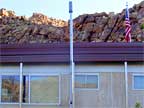 It is very important to install the vent stack correctly, projecting three feet above the peak of the roof so that passing breezes will naturally pull air and moisture through the venting system when the fan and heater are off. The vent pipe that comes with the toilet is light-weight and this concerned me because we can get some pretty powerful winds gusting through this open terrain. To reinforce it, I attached an 8 foot C-shaped aluminum channel that I found at the local Barr Lumber. Home Depot did not carry this. It fit perfectly up into the vent diffuser on top of the stack, which locked that into place, and then it was bolted to the roof support beam that the pipe itself was clamped to below the roof's edge.
It is very important to install the vent stack correctly, projecting three feet above the peak of the roof so that passing breezes will naturally pull air and moisture through the venting system when the fan and heater are off. The vent pipe that comes with the toilet is light-weight and this concerned me because we can get some pretty powerful winds gusting through this open terrain. To reinforce it, I attached an 8 foot C-shaped aluminum channel that I found at the local Barr Lumber. Home Depot did not carry this. It fit perfectly up into the vent diffuser on top of the stack, which locked that into place, and then it was bolted to the roof support beam that the pipe itself was clamped to below the roof's edge.
It is a good idea to first determine exactly where the vent will be placed so that it is firmly attached with a minimum of elbows interfering with the natural flow of moist air. Then the toilet gets positioned for a direct connection to the vertical stack. They provide a roof gasket which is great if you are going straight up, but I did not want to cut a hole in the roof of my antique trailer, nor in the metal carport roof that protects the trailer. For that reason I went straight out through the wall to a carport post, and then up outside of the carport roof. To protect the hole in the wall from rain water flowing back in, I bought a 6" wide rubber bell-shaped gasket at HD that fits perfectly around the 2" vent pipe and a 6" plastic toilet flange (coincidentally) that anchors the gasket to the wall.
Before I measured for the hole in the wall, I bought a thick black rubber mat with a smooth non-porous surface at Home Depot to cushion the system, protect the wood floor, keep bare feet warm, and to catch the inevitable spray that fans out when a man is relieving himself. Normally invisible, that spray becomes visible when passing through rays of sunlight streaming through a window. That is probably why bathroom floors are not carpeted. Women are clean; men are not - deal with it.
The package also included two other items that I did not use, which I may regret. Or not; we will see. It included an 8 foot length of foam insulation for wrapping around the vent stack. Since we would not get freezing temperatures within the stack that could last long enough to worry about, and since the occasional power burst of wind would probably make short work of it unless I wrap it in tape top to bottom, and since it would not be as interesting to look at as the vent stack itself, I put it away.
I also did not use the drain hose provided. There are two capped drain elbows on the rear bottom corners of the toilet. They are there to capture an overflow of filtered urine should the need arise. I did not want to drill another hole or two in my floor so I decided to wait and see. I keep my eye on it. Though the compost absorbs, dilutes and breaks down most urine, some did puddle on the interior floor of our toilet, especially in the beginning when there was not as much compost to soak it up. That is what the imbedded heater is for. A light sprinkling of compost had also found its way into puddles. About 3 months later, there was some wet compost down there, which I spread around with the rake and will remove when enough accumulates, but there were no puddles.
Keep in mind that my wife had been gone about two months by then, so her contributions were gone. I also had to remind myself to make full use of the toilet instead of the more convenient urinal in my office/tool shed, because the composting process needs the liquid. Since I have to go there to get another cup of coffee anyhow, I might as well do both at the same time.
If we suddenly find ourselves entertaining a number of friends or family, I may have to reconsider. That will also mean having to bury a trash barrel septic tank for that hose to drain into. I hope my guests don't get concerned if I suddenly get up from a conversation and start drilling a hole in the floor.
People have told me that they have come across these toilets out in the wild and that the stench was really bad. That is what you get if it is poorly maintained. If the vent stack is installed with care and preferably where there is a natural updraft, if a scoop of compost mix is dumped on every bowel movement, and if a tbsp of microbe mix is sprinkled across the compost occasionally, than the smell will be minimal at best, and more like the smell of garden compost rather than that of a septic tank. If in the evening there is a slight smell of anything, running the fan for a few seconds will elliminate it completely and kick-start the draft in the right direction.
To the Image Series ...
Afterthoughts One Year Later ...
|
